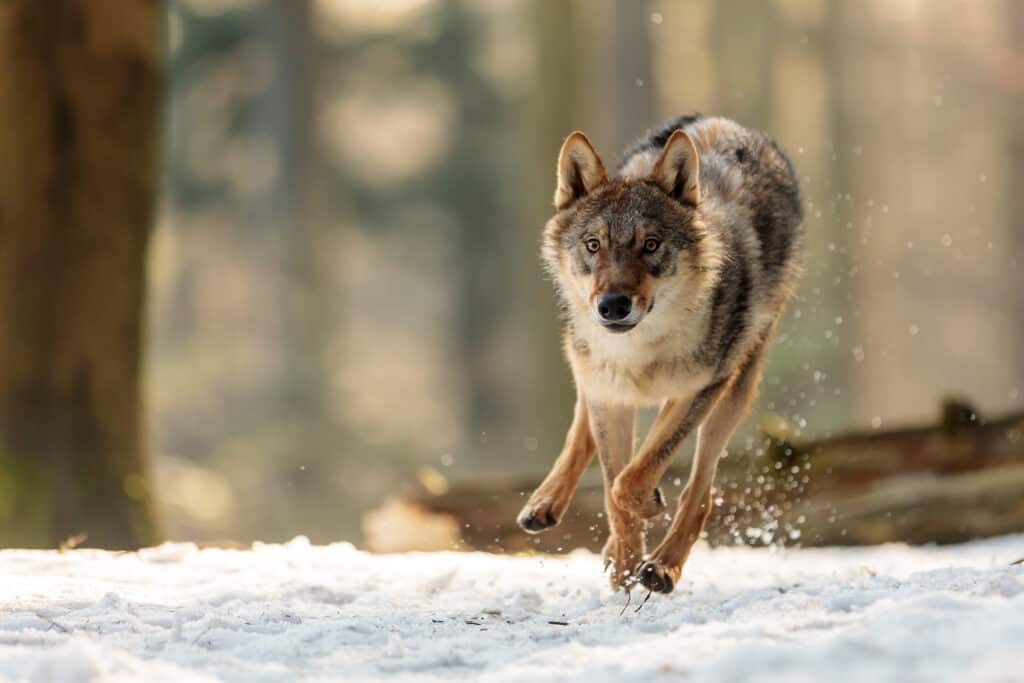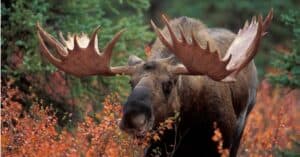The dogs we know of are often cuddling with us at home or walking in the park. But not all “dogs” refer to the diverse breeds of domesticated dogs. The Canine family may seem countless because it includes all the dogs we encounter every day in our homes and all types of dogs in the wild. It’s difficult for those accustomed to domestic dog breeds to imagine dogs in their natural habitat. However, they exist and come in various breeds, including the dingo, bush dog, fox, wolf, jackal, coyote, and more.
In other terms, any member of the Canine family that doesn’t belong to any domesticated dog breed is considered a wild dog. Wolves are among the most well-known wild dogs and perhaps the mightiest. But did you know that the African wild dog is another efficient hunter in the wild? But how are they different? Below, we will explain the differences between the African wild dog and the wolf.
Comparing the African Wild Dog and Wolf
| African Wild Dog | Wolf | |
|---|---|---|
| Scientific Name | Lycaon pictus | Canis lupus |
| Size and Weight | – about 2.4 to 3.6 feet long and 2 to 2.5 feet tall when standing – grows an average of 39 to 79 pounds – tails are one and a quarter inches long | – about 4 to 6 feet long and 2 to 3 feet tall when standing – grows an average of 80 to 150 pounds – tails are about two feet long |
| Habitat and Distribution | – lives in savannas, deserts, arid areas, scrublands, woodlands, and mountains – can only be found in Africa | – grasslands, woodlands, tundras, forests, mountains, plains, and any kind of northern environment – can be found in North America, Europe, and Asia |
| Diet | – opportunistic predators that eat larger mammals such as warthogs, antelopes, gazelles, and wildebeest. They also consume birds, rats, lizards, and insects | – consume large hoofed mammals such as elk, deer, sheep, goat, bison, and moose. They also eat smaller prey like rabbits, rodents, beavers, and insects |
| Bite Force | 142 PSI | 406 PSI |
| Speed | 44 miles per hour | 35 miles per hour |
| Lifespan | 10 to 13 years | 10 to 12 years |
Key Differences between African Wild Dog and Wolf
While the African wild dog and wolf may come from the same family, their key differences are their scientific name, size and weight, habitat and distribution, diet, bite force, speed, and lifespan.
The African wild dog is a canine that originates from sub-Saharan Africa. It is sometimes referred to as the African painted dog or the Cape hunting dog and is the sole living member of the genus Lycaon. What makes it different from Canis is that it lacks dewclaws. It is the second-biggest wild canine species in the world and the largest in Africa.
The wolf, often known as the gray wolf or grey wolf, is a big dog indigenous to North America and Eurasia. There are more than thirty different subspecies of Canis lupus, and gray wolves are one of the wild subspecies. The wolf is the Canidae family’s largest living member.
Let’s take a closer look at each of their differences below.
African Wild Dog vs. Wolf: Scientific Name

The African wild dog is scientifically known as Lycaon pictus.
©iStock.com/Ondrej Prosicky
Scientifically known as Lycaon pictus, the African wild dog whose Latin name means “painted wolf,” can be distinguished from domestic dogs and other wild dogs by their vibrantly mottled fur. The only existing representative of the genus Lycaon differs from Canis by having a highly specialized dentition for a hypercarnivorous diet and lacking dewclaws.
Wolves, meanwhile, are known by the scientific name Canis lupus. The Latin word for “wolf” is “Lupus,” and the word for “dog” is “Canis.” Along with domestic dogs, coyotes, raccoons, and many other predatory species, wolves are members of the Canidae family.
African Wild Dog vs. Wolf: Size and Weight

Wolves measure around 4 to 6 feet long.
©Michal Ninger/Shutterstock.com
African wild dogs measure about 2.4 to 3.6 feet in body length and 2 to 2.5 feet in height when standing, and their tails are one and a quarter inches long. On average, they reach 39 to 79 pounds. Conversely, wolves are bigger and heavier, reaching about 4 to 6 feet long and 2 to 3 feet tall when standing. Their tails can grow to about 2 feet in length and they weigh from 80 to 150 pounds on average. Typically, female wolves weigh up to 40 pounds less than their male counterparts. In 1975, an impressive 175-pound wolf was killed in Alaska, making him one of the biggest ever caught.
The African wild dog can easily be recognized thanks to its gorgeously speckled fur, its most distinguishing characteristic. Its red, black, white, brown, and yellow fur has a random pattern of colors that is particular to each individual.
Most wolves have the same coarse, thick fur that is either gray or beige, even though many other subspecies have their own distinct coloration.
African Wild Dog vs. Wolf: Habitat and Distribution
Since the African wild dog and wolf are found in completely different settings, their habitats differ significantly. African wild dogs live in savannas, arid areas, deserts, scrublands, woodlands, and mountains. These wild dogs are endemic to Africa and can only be found on the continent. It is believed that there were once up to 40 African nations where the African wild dog could be found, but there are now only between 10 and 25. Most African wild dog communities are now confined to national parks in southern Africa, with Botswana and Zimbabwe having the biggest populations. African wild dogs need expansive domains to sustain the pack. As home ranges have shrunk, so have pack sizes.
On the other hand, wolves are found in North America, Europe, and Asia, making their habitats more diverse. They prefer environments with many covers and spaces to roam. Wolves can be found in practically every type of northern environment, including grasslands, woodlands, tundras, forests, mountains, and plains, as they are not restricted to any particular type of landscape. It’s rare to ever encounter a wolf in the southern regions of their respective continents because of their big size and thick fur, which prefer frigid climes.
African Wild Dog vs. Wolf: Diet

Wolves are carnivores that eat larger hoofed mammals like elk, deer, sheep, and moose.
©Nagel Photography/Shutterstock.com
When it comes to food and hunting, wolves and African wild dogs do not differ a lot. Both species are carnivores and prefer to hunt larger mammals. The wild dog hunts larger prey on the African plains in large packs. It is a voracious and opportunistic predator that preys on warthogs, antelopes, gazelles, and wildebeest. African wild dogs also eat smaller prey such as insects, birds, rats, and lizards. They also move in groups, giving the impression that they are hostile and aggressive.
Wolves are also carnivores that feed on large hoofed mammals such as elk, deer, sheep, goats, bison, and moose. They also eat smaller prey like rabbits, rodents, beavers, and insects. These creatures will consume almost any kind of prey they can capture. An average wolf consumes the equivalent of 15 deer a year.
African Wild Dog vs. Wolf: Bite Force
A wolf has a bite force of 406 pounds per square inch, compared to the 142 pounds per square inch of an African wild dog.
The wolf also has larger canine teeth than the African wild dog, which explains why it can kill the latter relatively quickly. However, defeating the wild dog is not easy because they are highly cunning and can readily identify their foe’s weak points.
African Wild Dog vs. Wolf: Speed
Compared to wolves, African wild dogs run faster. Wolves have a top speed of 35 miles per hour, whereas African wild dogs may sprint at more than 44 miles per hour. While the African wild dog’s prey is frequently considerably faster, the pursuit can extend for miles, and coupled with their ability to sustain the pace, this dog’s endurance and perseverance contribute to its success.
Nevertheless, wolves would still prevail over African wild dogs in a battle 80% of the time, even with this edge. While the African wild dog is slightly quicker and more agile, almost all wolves are heavier and have a greater punch. Wolves have an advantage over wild dogs since they are more powerful and enormous. A wild dog’s bite will hurt, but a wolf’s bite will be more painful.
African Wild Dog vs. Wolf: Lifespan
Wolves can live up to 14 years in the wild, while African wild dogs can live for 10 to 13 years. But since animals kept in captivity have been known to live for 15 years, certain wolves in the wild likely have the same longevity. Madadh was the oldest wolf ever recorded. With the aid of her caregivers, she lived to be 19 years old. As they age, these creatures may experience joint issues, battle wounds, and the consequences of starvation.
Up Next:
Thank you for reading! Have some feedback for us? Contact the AZ Animals editorial team.








